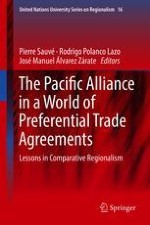2019 | OriginalPaper | Buchkapitel
10. Situating the Pacific Alliance in Global Electronic Commerce Regulation
verfasst von : María del Carmen Vásquez Callo-Müller
Erschienen in: The Pacific Alliance in a World of Preferential Trade Agreements
Aktivieren Sie unsere intelligente Suche, um passende Fachinhalte oder Patente zu finden.
Wählen Sie Textabschnitte aus um mit Künstlicher Intelligenz passenden Patente zu finden. powered by
Markieren Sie Textabschnitte, um KI-gestützt weitere passende Inhalte zu finden. powered by
